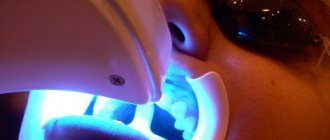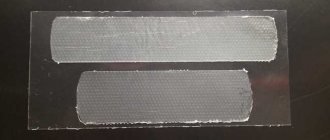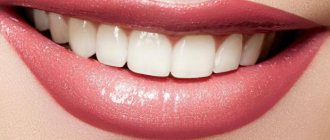What is photo teeth whitening?
For your information! Photo whitening, or as it is also called “light whitening,” is a fast and safe dental procedure that can whiten tooth enamel by 10-12 shades at a time.
During photo-whitening, a special composition is distributed onto the teeth , the main active ingredients of which are hydrogen peroxide and carmabide.
Activated under the influence of lamp light and penetrating into the deep layers of dentin, they destroy unwanted color pigments.
The type of lamp is selected depending on the condition of the dental bone, soft tissues and natural enamel pigment.
When photobleaching, lamps with the following variations of light radiation are used:
- Ultraviolet lamps - lamps of this type are considered somewhat outdated, since during operation they emit heat and heat tooth enamel.
- Halogen - the light from these lamps is cold, which minimizes tissue trauma.
- LEDs are currently the safest cold-glow lamps.
It is worth noting! The entire lightening procedure takes an average of 1 hour and is carried out in several stages:
- Dental examination. The doctor examines the patient’s teeth and mucous tissues for contraindications. For example, if there is tartar or caries, they will need to be eliminated first and only then proceed to whitening.
- Modeling the desired result . The patient indicates what effect he would like to get from whitening using a special sign. In some clinics, the patient is shown the “before and after” result using computer modeling.
- Protecting fabrics from lamp light . The patient's gums and inner cheeks are covered with a special protective plate. This step is necessary to minimize the likelihood of light or chemical burns.
- Distribution of gel over tooth enamel. As a rule, only the “smile zone” is treated, that is, 10 teeth of the upper and lower jaw that are visible when smiling, laughing and during communication.
- Protect your eyes from lamp light . Both the doctor and the patient wear special protective glasses to prevent retinal burns.
- Applying gel to teeth and whitening . The doctor distributes the gel over the patient’s tooth enamel and turns on the lamp. Exposure time is 10-20 minutes. After this period, the gel is removed with a napkin, and its remnants are removed during rinsing. There can be up to 6 applications in 1 session.
- Checking the result using the Vita scale . After all manipulations with the teeth are completed, the doctor gives the client a mirror and a Vita scale (a strip on which all possible shades of tooth enamel are depicted). This is done so that he can clearly see what results were achieved.
- Consultation on further oral care.
Professional teeth whitening ZOOM 4: general information
The ZOOM 4 professional teeth whitening technology was developed in the USA and quickly became popular and in demand among dentists and patients all over the world; Moscow dental clinics also offer the ZOOM 4 tooth enamel lightening service to their patients.
When using ZOOM 4, lightening of tooth enamel is achieved through the action of a special preparation that is used to treat tooth surfaces. This drug contains hydrogen peroxide in high concentration (25%), which can destroy pigmented particles that cause darkening of natural tooth enamel. A substance such as calcium phosphate is also present in the whitening gel formula. It does not help in whitening, but it does help maintain the integrity of tooth enamel and strengthen it.
After application to the teeth, the gel does not immediately begin to work for whitening - it must be activated with the cold light of an LED lamp. Under light exposure, the drug begins to disintegrate and during this reaction, the process of releasing oxygen atoms occurs, penetrating deep into the enamel and dentin and dissolving pigments.
Teeth whitening ZOOM 4 uses specialized lamps produced by the Philips brand - Philips Zoom White Speed. These lamps have three operating modes, each of which provides its own power. This allows the dentist to select the strength of light exposure on dental surfaces individually for each patient and thus make ZOOM 4 teeth whitening not only effective, but also safe.
What types are there?
Stay up to date! Most dental clinics in the CIS countries offer the following photo-whitening techniques:
- Beyond Polus is a symbiosis of halogen and LED radiation, which makes the procedure safer for enamel. One whitening session usually consists of three cycles of 10 minutes each. The effect lasts up to a year, after which the procedure can be repeated.
- Luma Cool - this technique uses exclusively cold-light LED lamps. This makes it absolutely safe for both teeth and soft tissues. One session consists of three cycles of 8 minutes each. The result lasts for several years.
- Zoom is perhaps the most famous photo-bleaching technique, which is performed using a UV lamp. Ultraviolet radiation produces heat, which is quite detrimental to enamel. But, nevertheless, Zoom gives the most pronounced effect among all the above procedures. Whitened teeth retain their newfound color for up to one and a half years.
After a photo-whitening session, tooth enamel becomes more sensitive, which is why drinking hot and cold drinks is accompanied by unpleasant sensations.
Note! This is a temporary phenomenon that completely disappears in 3-5 days.
Painter-plasterer
The third editor that will help you make a white background in a photo is called Snapseed . The application is free and available in the official AppStore and Google Play .
Instructions on how to make a white background in a photo:
- Open the photo in the program.
- Next follow: Tools - Brush - Saturation .
- Set Saturation to -5 or -10. Swipe your finger across the screen to whiten areas of the photo.
- Next follow: Tools - Brush - Exposure .
- Set Exposure to -0.3 and also slide your finger across the screen.
- Play around with the values until the picture is perfect.
The result of background whitening in Snapseed .
Indications and contraindications
Many things can affect the color of enamel - genetic predisposition, abuse of cigarettes and coloring products, and even treatment with antibiotic drugs.
Indications
You should know! The desire to make your smile more aesthetic is the main indication for the procedure.
Photo whitening will help you if your teeth:
- They have uniform pigmentation without light and dark stripes and other inclusions.
- Well formed and have naturally strong enamel without grooves, chips or cracks.
Contraindications
You will have to refuse the photobleaching procedure if you are limited by one of the following factors:
- Pregnancy and lactation period.
- Age under 18 years.
- Thin and sensitive enamel.
- Caries.
When is it better to stop using ZOOM 4 teeth whitening?
ZOOM 4 whitening is recognized by experts as a gentle technique that does not lead to destruction of dental tissue and enamel, but in some cases, if there are certain contraindications, it cannot be performed.
These contraindications to ZOOM 4 whitening include:
- A large number of fixed dentures and large fillings in the oral cavity. The fact is that the ZOOM 4 whitening procedure can only make natural tooth enamel whiter, but crowns and fillings will not become lighter from photo-whitening;
NOTE: Can ZOOM 4 whitening be used to lighten fillings? This question is often heard on various dental forums on the Internet. However, the answer to this will be negative - no whitening technique can make either fillings or dentures lighter. If you want ideal whiteness of teeth on which there are fillings, it is better to choose another technique used in aesthetic dentistry - installing veneers. Another possible option is to replace old fillings with new restorations after bleaching.
- Teeth whitening ZOOM 4 is not carried out during the period of bite correction with braces and for six months after its completion;
- Zoom 4 is contraindicated for use during pregnancy and lactation;
- Teeth whitening is not performed on children and teenagers. The procedure is contraindicated for young patients because the process of teeth formation is still ongoing until the age of 18; teeth whitening during this period can do more harm than good;
- ZOOM 4 is contraindicated in the presence of cancer, mental disorders, or abnormally high sensitivity of teeth.
Before whitening, it is necessary to cure teeth affected by caries, eliminate gum inflammation, and remove accumulated plaque and tartar from the surfaces of teeth. If this is not done, the effectiveness and usefulness of ZOOM 4 will be reduced to zero.
NOTE: ZOOM 4 does an excellent job of removing pigmented plaque caused by smoking. However, if after Zoom 4 whitening a person continues to smoke and does it often, the positive effect of the procedure will be extremely short-lived!
Advantages and disadvantages
The procedure has gained worldwide fame precisely thanks to its extensive list of advantages :
- Quick results - just one hour-long session and teeth become 10-12 shades lighter.
- Durability – the result lasts from 1 to 3 years.
- safety – compared to older enamel lightening methods.
Keep in mind! But it was not without its drawbacks:
- Temporarily makes teeth more sensitive - this causes discomfort during meals.
- Does not lighten fillings, veneers, dentures and crowns - they will need to be changed after whitening.
- It is quite expensive - which for many is a decisive factor for refusal.
How to maintain the result after photobleaching?
After the tooth enamel whitening the doctor conducts a consultation with the patient and gives him a list of recommendations for maintaining a new snow-white smile in its original form.
You should know! To maintain tooth enamel in a clean form, the patient should adhere to the following tips:
- For the first 1-2 weeks, refrain from eating coloring foods and drinks (red and blue berries, tea, coffee, lemonade).
- In the first 3 days, avoid eating excessively hot and cold foods, in order to once again cause yourself discomfort.
- Replace your usual toothbrush with a softer one.
- Buy toothpaste with a high content of fluoride and calcium.
- Buy floss (dental floss) and carry it with you everywhere to get rid of food debris if you are away from home.c
If you cannot deny yourself the pleasure of drinking coffee, juice or lemonade, drink drinks through a straw.
average price
Need to know! The price for the photobleaching service is determined depending on the following factors:
- City – in Moscow and St. Petersburg prices are significantly higher than in the regions.
- The reputation of the clinic - the more highly qualified doctors and better equipment the clinic has, the higher the price tag. This is exactly the case when the price justifies the quality.
- Methodology used. For photo whitening Zoom the price tag varies from 15,000 to 25,000 rubles, for Beyon Polus - from 10,000 to 20,000 rubles, and for Luma Cool - from 6,000 to 14,000 rubles.
Reviews about the procedure
Below are some reviews. If you have something to say, leave your feedback in the comments below the article, it will be useful to our readers.
Marina, Moscow.
Teeth are my sore subject. They are naturally yellowish, plus I simply cannot imagine myself without coffee. I was thinking about getting veneers or whitening my teeth. In the end, I chose the second one and did not regret it. It’s been 3 months since I became the owner of a Hollywood smile! Despite my enormous fear of dentists, I endured the procedure calmly - I just lay there while the lamp did its job.
Rinata, Novosibirsk.
My daughter had her teeth photobleached - she wanted to look 100% at her prom. My teeth certainly became whiter, but terrible sensitivity of the enamel appeared. For the first week after going to the clinic, my daughter could not eat or drink anything without wincing in pain. She said that she liked the effect, but she was no longer ready to make such sacrifices for the sake of beauty. Now maintains the result with professional cleaning.
Method 2: Manual setup
The program recognizes all parts of the face, so each of them can be corrected separately. In the same automatic retouching section, go to the “Manual settings”
.
At the very bottom there is a “Teeth”
with the
“Whiteness”
. Move the slider to the right until you are satisfied with the result.
Adjust the whiteness value
You should not try to whiten your teeth completely in a photograph by turning the settings to the maximum. Too white teeth look unnatural. When viewing a portrait, people will immediately see that processing has been done, and not of the highest quality. Moderate whitening, on the contrary, will look beautiful and organic.
In female portraits, you can additionally adjust the lips. The corresponding block has settings for clarity, contrast, saturation and others. With their help you can make your lips more expressive and bright. Against their background, the person’s teeth in the photo will look even more snow-white and beautiful.
Make your lips brighter and more expressive










